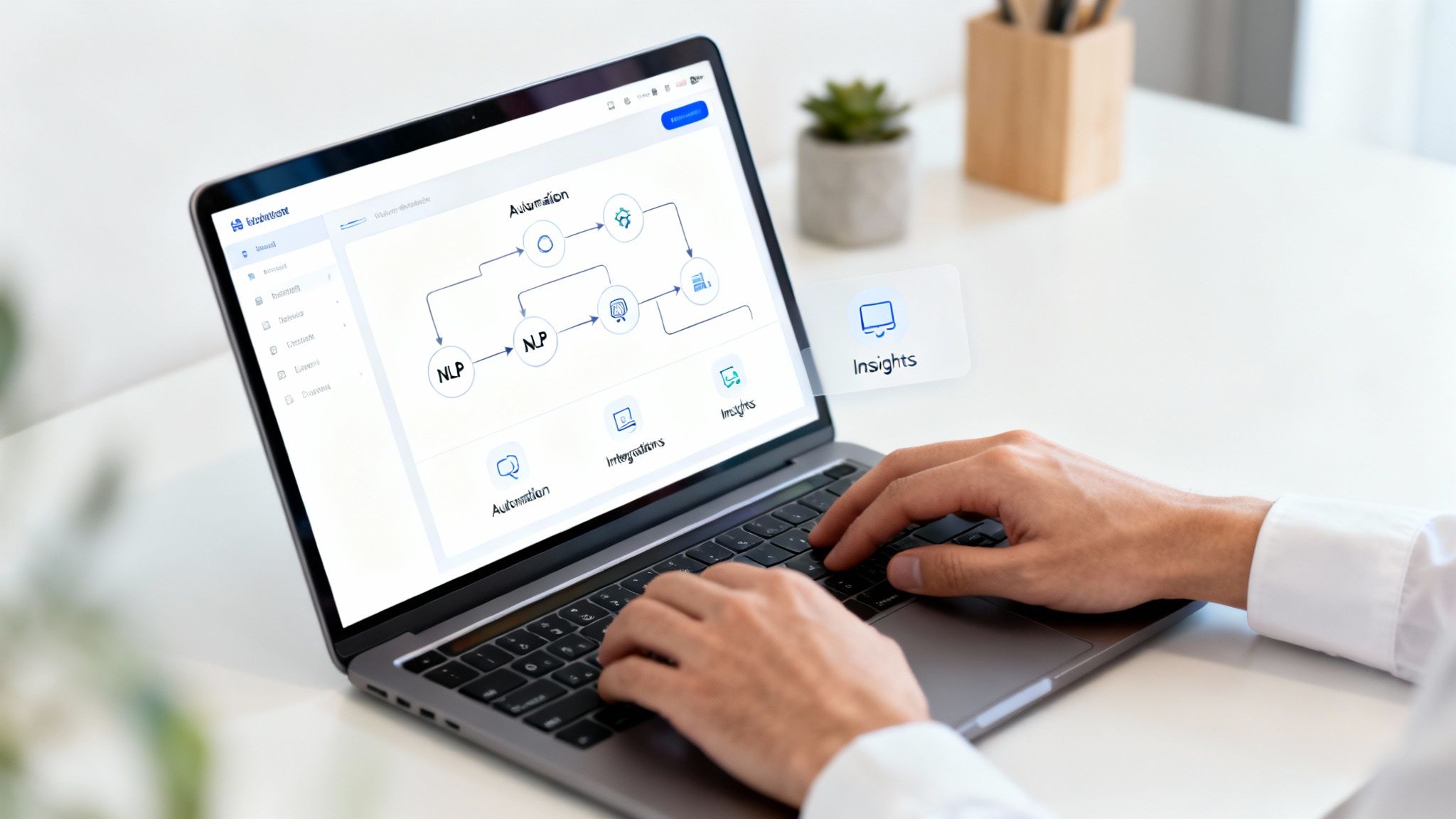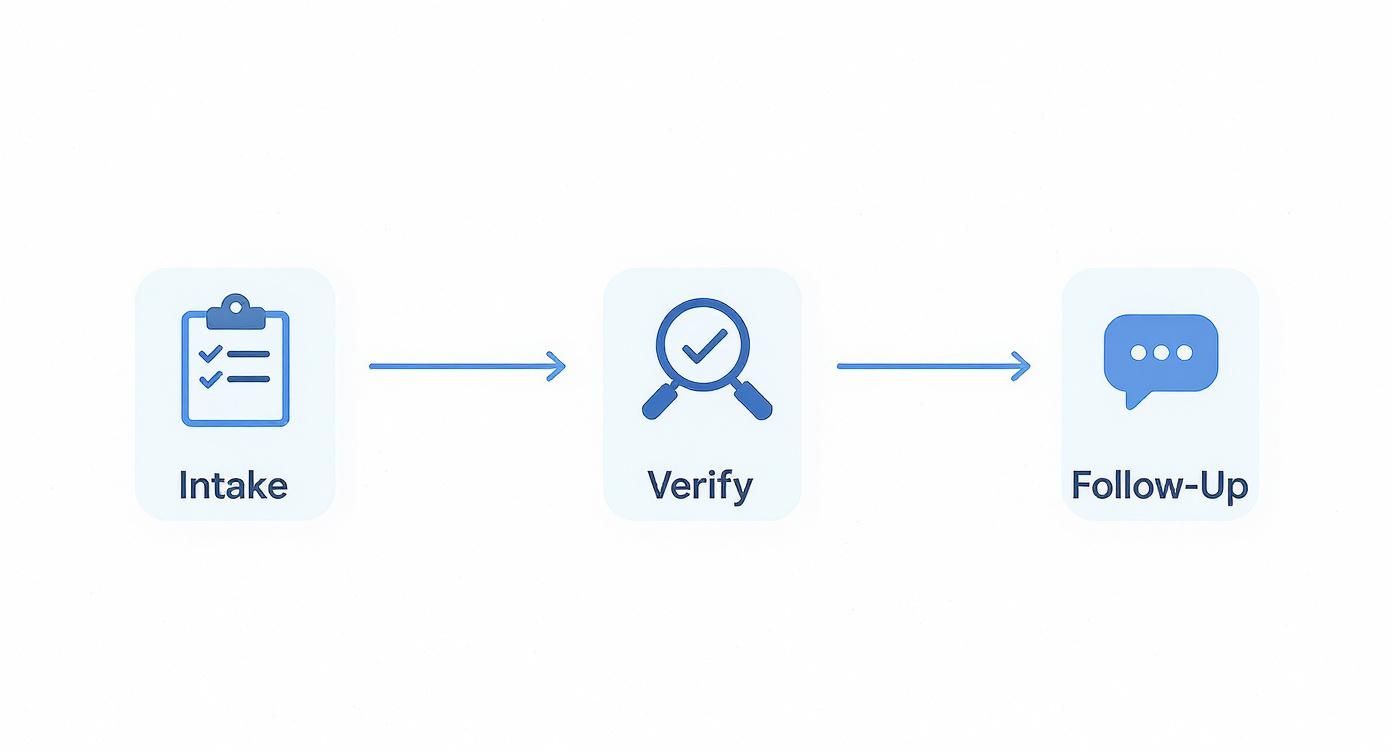Right, so what exactly is a personal AI assistant?
Think of it less like a simple chatbot and more like a highly skilled digital apprentice for your business. It's a digital team member that works around the clock, 24/7, handling all those repetitive tasks with flawless accuracy. You can train it to manage the specific, and often complex, workflows that are unique to your operations.
What Is a Personal AI Assistant Anyway?

Imagine being able to hand off all your client follow-ups, data entry, and appointment scheduling to a system that never needs a break, never makes a typo, and follows your instructions to the letter. This isn’t some far-off concept; it’s what a modern personal AI assistant does right now.
Unlike basic virtual assistants that just follow simple commands, these advanced tools actually learn your processes. They become a core part of your business, acting almost like a central brain that manages the constant flow of information.
The real goal here is to get all those predictable, time-sucking tasks off your plate. This frees you up to concentrate on the high-value work that actually grows your business—things like closing deals, giving expert advice to clients, and building solid relationships.
More Than Just Basic Automation
A proper personal AI assistant goes way beyond just ticking off tasks. It’s built to understand nuance and context, which is where the magic really happens.
For instance, it can read an incoming client email, figure out what they need, pull the right information from your database, and then draft a personalised reply—all based on the rules you’ve set up. This kind of capability is quickly becoming a must-have for busy professionals.
In fact, AI adoption in Australia is taking off. A 2025 Ipsos survey found that a whopping 49% of Australians have used generative AI in the past year. What’s really telling is the excitement around AI’s potential as a personal assistant for scheduling and planning, with 55% of people keen on it. This shows a clear shift towards weaving these tools into our professional lives. You can dig into these AI adoption findings over on Google's blog.
A personal AI assistant isn't just about doing things faster. It's about creating an intelligent system that gets your business rules and executes them perfectly every time, letting you scale up your efforts without scaling up your workload.
How Is It Different From a Traditional Assistant?
So, how does this stack up against a human assistant? The main differences come down to scalability, cost, and consistency.
While a human assistant is brilliant for creative thinking and complex problem-solving, a personal AI assistant is an absolute powerhouse at executing defined processes on a massive scale. It can juggle thousands of client enquiries at once without breaking a sweat or letting quality slip—something no person could ever do.
This is a game-changer for service-based professionals who are constantly buried under a high volume of repetitive communication. To make it clearer, let's break it down.
Traditional Assistant vs Personal AI Assistant
Here’s a quick look at how a personal AI assistant can complement your workflow in ways a traditional assistant can't.
| Attribute | Traditional Assistant | Personal AI Assistant |
|---|---|---|
| Availability | Works standard business hours. | Operates 24/7, 365 days a year. |
| Scalability | Limited to one task at a time. | Manages thousands of tasks simultaneously. |
| Consistency | Performance can vary. | Flawless accuracy on defined tasks. |
| Cost | Involves salary, benefits, and overhead. | A fixed, predictable subscription fee. |
As you can see, a personal AI assistant doesn't replace human expertise; it enhances it. It creates a much more efficient and responsive business by taking care of all the operational noise, so you can focus on what really matters. With support from organisations like Australia's National AI Centre, these tools are only going to get smarter and more capable.
The Core Capabilities That Matter Most

When you look under the bonnet of a truly effective personal AI assistant, you'll find it's much more than a fancy task manager. Sure, basic tools can set reminders or answer simple questions, but a professional-grade assistant is powered by a set of core capabilities that all work together. Think of it less as a single tool and more as an intelligent, responsive system.
Understanding these capabilities is key. It’s what helps you see how an AI can go from just reacting to your commands to actually anticipating what your business needs next. It's the difference between a digital checklist and a digital team member who genuinely gets how you operate.
Understanding Your Language and Intent
First up, and arguably the most crucial piece of the puzzle, is Natural Language Processing (NLP). This is the tech that lets the AI read and understand human language—whether it's buried in an email, a quick text message, or a transcribed voicemail. It’s basically a translator who's fluent in both "human" and "computer."
Imagine a new client enquiry landing in your inbox. A basic system might just flag it as a new email. Big deal. But an AI with solid NLP can read the message, pick out the sender's name, figure out they're asking for a home loan pre-approval, and even pull out key details like their requested loan amount and the property's location.
This ability to grasp context and nuance is what separates a powerful personal AI assistant from a simple script. It’s how the system chews through messy, unstructured information and spits it out as clean, actionable data, all without you lifting a finger.
Automating Your Unique Workflows
Once the AI understands what’s being asked, it needs to know what to do about it. That's where intelligent workflow automation comes into play. A workflow is just the series of steps you follow for any given process, like onboarding a new client or following up on a property viewing.
An advanced assistant lets you map out these multi-step processes so it can handle them automatically. We’re not talking about one-off tasks here; we're talking about running an entire sequence of actions from start to finish.
For a mortgage broker, it might look something like this:
- Step 1: The AI gets a new lead email (using its NLP smarts).
- Step 2: It automatically creates a new client profile in your CRM.
- Step 3: It shoots off a personalised welcome email with a link to your online application form.
- Step 4: If the form isn't touched within 48 hours, it sends a gentle nudge.
This whole chain reaction happens in the background, making sure every single lead gets a prompt, professional, and consistent experience from the get-go.
Connecting Your Business Tools
Let's be real—no one works in a vacuum. You rely on a whole suite of software to get things done: your CRM, email, calendar, you name it. A top-tier personal AI assistant has to have seamless software integration to act as the central hub connecting all these different tools.
An AI assistant’s real power isn’t in replacing your favourite software; it’s in making all of it work together more intelligently. It becomes the conductor of your digital orchestra.
This integration is what allows the AI to "talk" to your other apps. It can pull client info from your CRM to personalise an email, book a meeting straight into your calendar, and file signed documents in the right cloud folder. Without this deep connectivity, the AI is just another isolated tool, and its effectiveness plummets.
Learning to Sound Like You
Finally, the most sophisticated assistants bring deep personalisation to the table. This is about so much more than just plugging a client's first name into an email template. It means the AI learns your specific communication style, your tone of voice, and your unique business rules.
By analysing your past emails and messages, the AI picks up on how you interact with clients. Are you more formal or casual? Are there certain phrases you always use when chasing up documents? By learning these patterns, your assistant can generate responses that are practically indistinguishable from your own.
This ensures that even when your communication is automated, it still feels authentic. It keeps that personal touch that’s so vital for building strong, lasting client relationships. This is the final layer that turns the AI from a simple tool into a true extension of you and your brand.
How AI Assistants Actually Deliver the Goods for Your Business

Sure, the tech behind a personal AI assistant is cool, but what really counts is how it moves the needle for your business. It's one thing to talk about 'efficiency' in theory, but it's another thing entirely to see it in practice—getting hours back in your day, making clients happier, and seeing a real impact on your bottom line.
The real magic happens when you move beyond just getting tasks done and start creating solid, automated systems that hum along in the background. This is what finally lets busy professionals step off the administrative treadmill and put their energy where it matters most: on strategic, high-value work.
Getting Your Most Valuable Asset Back: Time
For any professional selling their expertise, time is literally money. A personal AI assistant is built to claw back all those hours you lose each week to the grind of repetitive, non-billable jobs. Think about all the time sunk into chasing up documents, answering the same client questions over and over, or plugging details into your CRM.
Picture a mortgage broker who burns hours every single week just following up with clients for payslips and bank statements. An AI assistant can take over that entire dance, sending out personalised reminders and even sorting the documents as they land in your inbox. That alone can free up 10+ hours a week—time that could be spent nurturing hot leads or closing more deals.
Wiping Out Costly Human Slip-Ups
Manually entering data and handling repetitive communication isn't just a time-suck; it's a minefield for human error. One little typo in a client's details or a forgotten follow-up can snowball into compliance headaches, broken trust, and lost opportunities.
An AI assistant just doesn't have off days. By automating how data and messages are handled, it makes sure every process runs perfectly, exactly how you set it up, every single time. This slashes the risk of those costly mistakes that can really damage your professional reputation.
This kind of precision is a game-changer, especially in fields like real estate and finance where getting the details right is non-negotiable. The AI becomes your tireless quality control manager, keeping your data clean across every system you use. That means fewer mistakes, less time spent fixing things, and a much smoother operation all around.
Making Clients Happier and Being More Responsive
In today's market, how fast and how well you respond can be the difference between winning and losing a client. People expect instant answers and proactive updates, but nobody can be switched on 24/7. This is where a personal AI assistant gives you a serious leg up on the competition.
It can jump on new enquiries the moment they come in, day or night, book appointments, and give clients status updates without you lifting a finger. This ensures no lead ever goes cold and every client feels like they're getting top-notch, professional service.
- Jump on Leads Instantly: A real estate agent can have their AI qualify new property enquiries and schedule viewings right away, catching people when they're most interested.
- Offer 24/7 Client Support: A financial advisor's assistant can answer common questions about onboarding paperwork at 10 PM on a Sunday, adding value well outside of office hours.
- Send Proactive Follow-ups: The system can automatically ping clients with reminders about upcoming deadlines, keeping everything on track and making them feel looked after.
A huge part of how AI assistants deliver this value is through smart workflow automation. By setting up these intelligent sequences, you create a standout client experience that builds trust and loyalty, which ultimately turns into more referrals and repeat business. These real-world benefits show that a personal AI assistant isn't just another productivity app; it's a proper strategic asset for growing your business.
Seeing Personal AI Assistants in Action
Talk is cheap, right? It’s one thing to hear about the benefits of a personal AI assistant, but it’s another thing entirely to see how it actually solves real-world problems. This is where the penny drops. We’re moving from theory to the street, showing you exactly how professionals are using this tech to get on top of their biggest, most draining tasks.
Each story here follows the same simple arc: a common business headache, the AI-driven fix, and the impressive outcome. Think of these as a blueprint for what becomes possible when you bring a smart digital helper into your daily grind.
For the Swamped Mortgage Broker
Let's start with a classic scenario. Picture Sarah, a successful mortgage broker. Her problem isn't getting leads; it's the sheer volume of paperwork and admin that follows every single application. She’s burning hours chasing up documents like payslips and IDs, sending the same follow-up emails over and over, and handling the initial client intake.
The Headache: Sarah is bogged down in low-value admin, which puts a hard cap on how many new clients she can realistically help. The manual process is not only slow but also invites simple mistakes, and the client experience suffers when she’s flat out.
The AI Fix: Sarah gets a personal AI assistant set up to handle her specific onboarding process.
- First Contact: A new lead comes in, and the AI immediately shoots off a personalised welcome email with a link to her secure online application form. No delay.
- Document Chasing: The assistant automatically follows up with clients for any missing documents based on a schedule she sets. As they come in, it ticks them off a checklist.
- Keeping Clients Warm: It sends automated updates to clients, letting them know their application is moving along without Sarah having to lift a finger.
The Result: Sarah gets back over 10 hours every week. That’s time she now spends giving expert advice and closing more deals, which has massively boosted her capacity and income. On top of that, her clients are happier because the whole process feels slick, professional, and super responsive.
For the Real Estate Agent Who’s Always On
Now, let's look at David, a real estate agent juggling hundreds of enquiries across multiple listings. He’s in a constant battle with his phone, trying to keep up with calls, texts, and emails. He knows he’s missing opportunities simply because he can't get back to everyone instantly, especially after hours.
The Headache: Leads are going cold. David can’t provide the immediate, 24/7 response that people now expect. Trying to schedule viewings is a messy game of phone tag, and nurturing anyone who isn't ready to buy right now is practically impossible.
The AI Fix: David’s personal AI assistant becomes his frontline enquiry manager.
- 24/7 Lead Catcher: The AI replies to every single property enquiry within seconds. It answers the common questions and qualifies how serious the person is.
- Hands-Off Scheduling: It syncs with David's calendar and lets potential buyers or renters book a viewing time that works for them, straight from the initial chat.
- Nurturing on Autopilot: For those cooler leads, the AI sends out market updates and alerts for new listings, keeping David top-of-mind until they’re ready to make a move.
The Result: David's lead conversion rate skyrockets because every single enquiry gets a prompt, professional reply. His calendar fills up with qualified appointments automatically, and he’s no longer stressing about the calls he missed. This organised approach gives a much clearer visualisation of the client journey.
A personal AI assistant flips your business from being reactive to proactive. It builds a system that guarantees every client and every lead gets a first-class experience, no matter how busy you get.
It's Not Just About Property and Finance
These examples are just the tip of the iceberg. The same ideas work across countless other professional services. Before we dive into more industries, let’s quickly break down some common applications.
Here’s a snapshot of how personal AI assistants are being put to work across different sectors in Australia.
Personal AI Assistant Use Cases by Industry
| Industry | Primary Use Case | Key Benefit |
|---|---|---|
| Financial Services | Streamlining client onboarding and compliance checks | Reduces risk and frees up advisors for high-value strategic work. |
| Trade Businesses | Handling incoming job enquiries and scheduling appointments | Captures every lead and stops the phone from disrupting paid work. |
| Strata Management | Managing member communications and maintenance requests | Ensures timely responses and creates a clear record of all interactions. |
| Legal Practices | Automating initial client intake and document collection | Speeds up case preparation and allows lawyers to focus on legal work. |
| Consulting | Qualifying new leads and scheduling discovery calls | Fills the pipeline with qualified prospects without manual follow-up. |
As you can see, the core principle is universal: offload the repetitive, high-volume tasks to a smart system.
This shift is already well underway in other areas, like e-commerce. Recent research shows that in Australia, 48% of shoppers have already used AI assistants for finding products, and a massive 61% trust the AI-generated recommendations they get. This growing trust in AI to simplify complex choices is a powerful indicator of what’s to come for professional services.
Whether it’s booking jobs for a busy plumbing business or handling communications for strata management, the big win is always the same. A properly trained personal AI assistant takes over the grunt work, freeing up human experts to do the work that actually requires their skill and experience.
Getting Started With Your First Personal AI Assistant
Taking the plunge and adopting a personal AI assistant can seem like a massive project, but if you break it down, it's actually pretty straightforward. The trick is to start with a clear, simple strategy. Forget trying to automate your entire business overnight. Instead, pick one or two of the most repetitive, high-impact tasks that are currently eating up your time.
What do you do every single day, without fail? Is it answering the same initial questions from new clients? Chasing up paperwork? These are the perfect places to start because you'll see a quick, measurable return on your effort.
This flow chart gives you a good idea of how a typical AI-driven workflow runs, from the first point of contact right through to the final follow-up.

As you can see, the AI can systematically handle client intake, check details, and manage communications, making sure nothing slips through the cracks.
Choosing the Right Tool for the Job
Once you’ve pinpointed a workflow to tackle, the next step is picking the right platform. Not all AI assistants are created equal, so you need to look at them based on what will actually make a difference to your business.
Here’s what really matters:
- Ease of Setup: How fast can you get up and running? A good system shouldn't require a degree in computer science to set up. Look for a clean interface and simple instructions that let you build and launch your first workflow in hours, not weeks.
- Integration Power: Your AI assistant has to play nicely with the tools you're already using—think CRM, email, and calendar. This is the secret sauce that makes true end-to-end automation possible.
- Scalability: The right tool will grow alongside your business. It needs to handle more and more tasks without slowing down, ensuring it stays a valuable part of your toolkit as you expand.
- Security Protocols: Since your assistant will be handling sensitive client info, rock-solid security is a must. Make sure the platform follows strict data protection standards to keep client trust and stay compliant.
Rolling Out Your AI Assistant
With the right tool in your hands, it’s time for a strategic rollout. A successful launch is more than just flipping a switch; it’s about training the AI properly and tracking its impact.
Start by teaching the AI your specific business rules. For instance, if you’re a mortgage broker, you'd show it exactly which documents are needed for a pre-approval and the precise wording you use in your follow-up emails. This initial training is what turns a generic tool into a true extension of your business.
The goal here isn't just automation; it's intelligent automation. You're building a system that understands and executes your business logic, ensuring every interaction is consistent and high-quality.
This idea of customising AI to solve specific workplace problems is really taking off in Australia. A recent study found that 61% of Gen Z workers have already built or tweaked AI agents to automate parts of their job, and 83% said that senior leaders now come to them for AI advice. It’s a clear signal that businesses are moving towards proactive, personalised AI solutions, which makes choosing a flexible platform even more important.
Platforms like OnSilent are designed with this in mind. They offer a smooth onboarding process that takes the headache out of setting up complex communication workflows. The whole point is to get you started quickly so you can see a return on your investment, fast. With tools like the OnSilent smart voicemail app, professionals can start managing their calls and messages more effectively from day one.
By following these simple steps—find a key workflow, pick a solid tool, and train it on your business rules—you can get your first personal AI assistant up and running with confidence and start winning back your time almost immediately.
Common Questions About Personal AI Assistants
Diving into the world of a personal AI assistant usually sparks a few important questions. It’s completely natural to wonder about security, how flexible the system is, and what happens when things don't go exactly to plan. Getting straight answers is the key to feeling good about bringing this kind of tech into your business.
Let’s tackle some of the most common queries and concerns that come up.
Is My Client Data Actually Secure?
This is almost always the first question, and for good reason. When you're handling sensitive client information, from financial details to personal contacts, security isn’t just a feature—it’s everything.
Any reputable AI assistant platform is built with serious security from the ground up. These systems use end-to-end encryption, which means your data is scrambled and unreadable from the moment it leaves your device until it reaches its destination, and even when it's stored. They also have to follow strict data privacy rules, so access to your information is always locked down tight. Think of it like a digital vault where only you and your AI have the combination.
Since a personal AI assistant handles private data, knowing how to protect personal information online is more important than ever for keeping your clients' trust.
How Much Can I Customise the AI?
The short answer? Heaps. A professional-grade personal AI assistant isn't some rigid, off-the-shelf tool. Its real magic is in its ability to be shaped around your specific business processes and the way you communicate.
You can typically customise:
- Workflows: You get to map out the exact steps the AI takes for different jobs, like onboarding a new client or following up on a lead.
- Communication Tone: The AI can learn to match your unique voice. Whether you’re all business or a bit more casual in your emails and texts, it can adapt.
- Business Rules: You can teach it your specific rules of engagement, like when to flag an issue for a human or which clients always get top priority.
This level of personalisation makes sure the AI feels like a genuine part of your team, not just a generic add-on.
The best personal AI assistants are like clay, not stone. They are designed to be shaped around your unique operational needs, ensuring the automation feels authentic to your brand and serves your specific goals.
What Happens When the AI Encounters Something Unexpected?
That's a fair question. What if a client asks something totally out of left field, or sends a request in a weird format? A well-designed system doesn't just throw its hands up and crash; it has a plan for handling the curveballs.
Most systems have a built-in escalation path. When the AI gets stuck or isn't sure how to respond, it flags the conversation for a human to review. It won’t just take a wild guess and risk giving a wrong answer. Instead, it pauses that specific task and pings you to step in.
This creates a safety net, so you’re always in the driver’s seat. Plus, you can use these moments as learning opportunities to train the AI, making it even smarter and better equipped to handle more situations down the track.
Does This Mean I Lose All Human Oversight?
Not at all. A personal AI assistant is there to back you up, not take over. The whole point is to automate the predictable, repetitive stuff so you can focus your time and expertise where it really matters.
Human oversight is still a huge part of the process. You're the strategist—you design the workflows, set the rules, and jump in for those complex, nuanced conversations that need a human touch. The AI is the reliable executor, carrying out your instructions with perfect consistency, every single time. It's a partnership that lets you scale your business and give clients a better experience, without getting buried in admin.
Ready to see how an AI assistant can reclaim your time and streamline your communications? With OnSilent, you can automate your call and message management, ensuring you never miss an important opportunity.

